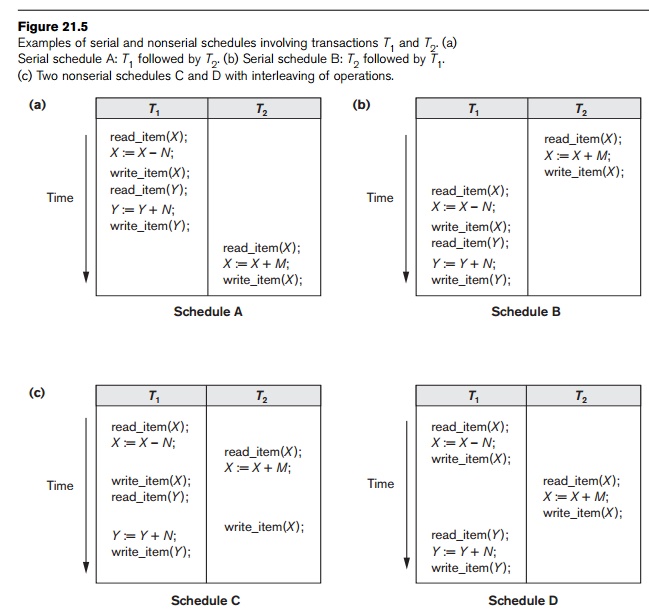

2nd and 3rd step happening at the same time. After rollback of the 1st transaction available seat is 10 again. Note that during the payment of 1st customer 2nd transaction read it 9 seat is available if some how 1st transaction Rollback then available seat 9 that is Dirty read data. view serializable schedule that is not conflict serializable has blind writes. Set transaction isolation level read uncommitted Our simplified schedules consist of only read and write instructions. Lets take an example to understand what I mean by that.
#Blind write in dbms serial#
To check whether a given schedule is view serializable, we need to check whether the given schedule is View Equivalent to its serial schedule. The twist is here if the first customer does not have sufficient fund in his debit card or in his wallet then the 1st transaction will Rollback, that time 9 seat available which is read by the 2nd transaction is Dirty Read.Īvailable ticket: For 2nd customer while 1st customer is paying for the ticket. View Serializability is a process to find out that a given schedule is view serializable or not. If we have a ticket booking system and One Customer is trying to book a ticket at that time available number of the ticket is 10, before completing the payment, the Second Customer wants to book a ticket that time this 2nd transaction will show the second customer that the number of the available tickets is 9. Note that if we put a valid ID first transaction result will come out as committed or 1 row effected but 2nd one will not be affected.
#Blind write in dbms update#
There is no partial commitment if both the UPDATE query succeed only then the output will be “Committed”. So at that time if we want to execute another transaction with that row that time Dirty Reads occurs. UPDATE Table SET Ballance = Ballance + 10 WHERE ID='C' īy executing the above query the output will be “Not committed” because there is an error, there is no ID=C. UPDATE Table SET Ballance = Ballance - 10 WHERE ID=1 Transfer 10 from S Adam account to Zee Young account: Input: It is mainly occurred because of multiple transaction at a time which is not committed. When a transaction is allowed to read a row that has been modified by an another transaction which is not committed yet that time Dirty Reads occurred. There are mainly four types of common concurrency problems: dirty read, lost read, non-repeatable read and phantom reads. This is again one of the most important topics for GATE. (c) Finish (Ti) : the time when Ti finished its write phase.Prerequisite – Types of Schedules, Transaction Isolation Levels in DBMS You can also expect some questions from ACID properties in DBMS. (b) Validation (Ti) : the time when Ti finishes its read phase and starts its validations phase.

But I need to add an exception for some reads, because an LSM has to search the memtable to insert key-value pairs. (a) Start (Ti) : the time when Ti started its execution. A blind write is done without hidden or explicit reads. Therefore, associate three different timestamps with each Ti : To perform the validation test, it is required to know when the various phases of transactions took place. (c) Write Phase : If the validation test succeeds for transaction Ti, The temporary local variables that hold the results of any write operations performed by Ti are copied to the database. If a transaction fails the validation test, the system aborts the transaction. This determines whether Ti is allowed to proceed to the write phase without causing a violation of serializability. This very simple and small transaction involves several low-level tasks. Suppose a bank employee transfers Rs 500 from A's account to B's account. Let’s take an example of a simple transaction. A single task is the minimum processing unit which cannot be divided further. (b) Validation Phase : The validation test is applied to transaction Ti. A transaction can be defined as a group of tasks.

It performs all write operations on temporary local variables, without updates of the actual database. It reads the values of the various data items and stores them in variables local to Ti. (a) Read Phase : During this phase, the system executes transaction Ti. The ‘validation protocol’ requires that each transaction Ti executes in two or three different phases in its lifetime, depending on whether it is a read-only or an update transaction. Writes of this sort are called ‘ blind writes ’. T1 T2 R(A) W(A) W(A) Here is a blind write that means write without a read. In the above schedule, Transaction T28 and T29 perform write(Q) operations without having performed a read(Q) operation. If there are two write operations of the different transaction on some data values and in between them there are no read operations then the second write over the first. Hence, this schedule is said to be ‘view serializable’. This schedule is ‘view equivalent’ to the serial schedule, since the one read(Q) instruction reads the initial value of Q in both schedules and T29 performs the final write of Q in both schedules.


 0 kommentar(er)
0 kommentar(er)
